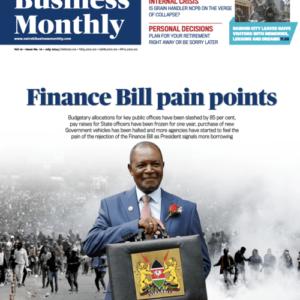BY PETER WANYONYI
The Kenya Revenue Authority (KRA) is charged with assessing and collecting all monies due to the government of Kenya. Some say it is also supposed to account for such monies, but that is a debate for a different forum, Kenya being Kenya. To facilitate collection of those revenues, the KRA has a whole host of accounts in every bank in the land. The account numbers are listed online on the KRA website. There’s an account for Customs Duty, another for Stamp Duty, and so on. In total, the KRA lists 93 bank accounts, each account being for a separate type of revenue.
In contrast, the New Zealand Internal Revenue Department (IRD) – whose functions in New Zealand are more or less similar to KRA’s functions in Kenya – lists just one bank account number on its website. This number is used for all payments to IRD.
Download Nairobi Business Monthly Latest Edition
Now, the New Zealand economy is far larger than Kenya’s economy. New Zealand’s 4.7 million people generate a GDP of $185 billion, which is over 2.6 times the size of Kenya’s. That means New Zealand therefore receives more in taxes than Kenya, and so the IRD is far busier than the KRA. So how is it, then, that the IRD can do all this with just one public bank account, while the KRA needs a plethora of bank accounts for far less work and much less money?
A hint of the answer lies in the list of KRA bank account numbers. KRA has a number of accounts in various banks for Customs Duty collection: at the Kenya Commercial Bank (KCB) the account number is 1122169973, at Equity Bank it is 0240299657063, at EcoBank it is 0010135018639601, and at Housing Finance Bank it is 704-0000604. A look at those account numbers shows one pattern: there’s no standard bank account number format. The KCB account is 10 digits long, the Equity account is 13 digits long, the Ecobank account is 16 digits long, and the HF Bank account has 11 characters, including one alpha-numeric character. Kenyan banks are therefore more or less free to come up with their own account numbers in their own formats. This is a weakness on the part of the Central Bank of Kenya, which has generally left standardisation in banking to the main sector lobby group, the Kenya Bankers Association.
But how is the IRD able to differentiate incoming monies to ensure that each line of revenue is fully accounted for? Standardisation! The New Zealand Banking sector has a standard that governs money transfer. When money is transferred in New Zealand, the transfer must include the following elements: the name of the payee (20 characters long, alphanumeric), the amount of the payment, the bank account number (18 digits – 2 digits for the bank, 4 for the branch, 8 for the actual account number, and 4 representing the account type), the “Particulars” of the payment (alphanumeric, 12 characters long), the Payment Code (alphanumeric, 12 characters long) and the Payment Reference (alphanumeric, 12 characters long).
When making a tax payment, the “Particulars” field takes the IRD number (equivalent to the KRA PIN number) of the entity paying, the Payment Code takes the type of payment (the IRD provides a list of payment types and their codes, such as “GST” – Goods and Services Tax – for Customs Duty), and the Payment Reference is a free field that can be used to provide more details about the payment.
The IRD is thus able to differentiate all received payments easily without having to maintain dozens of accounts – cutting costs and reconciliation efforts, providing funds traceability, and making tax payment straightforward. As Kenya looks to embrace e-commerce, payment platforms used in the country will need to be easily compatible with each other. This will in turn require standardisation of such things as payment formats, bank accounts, and so on. Banking standards would be a good place to begin!.



